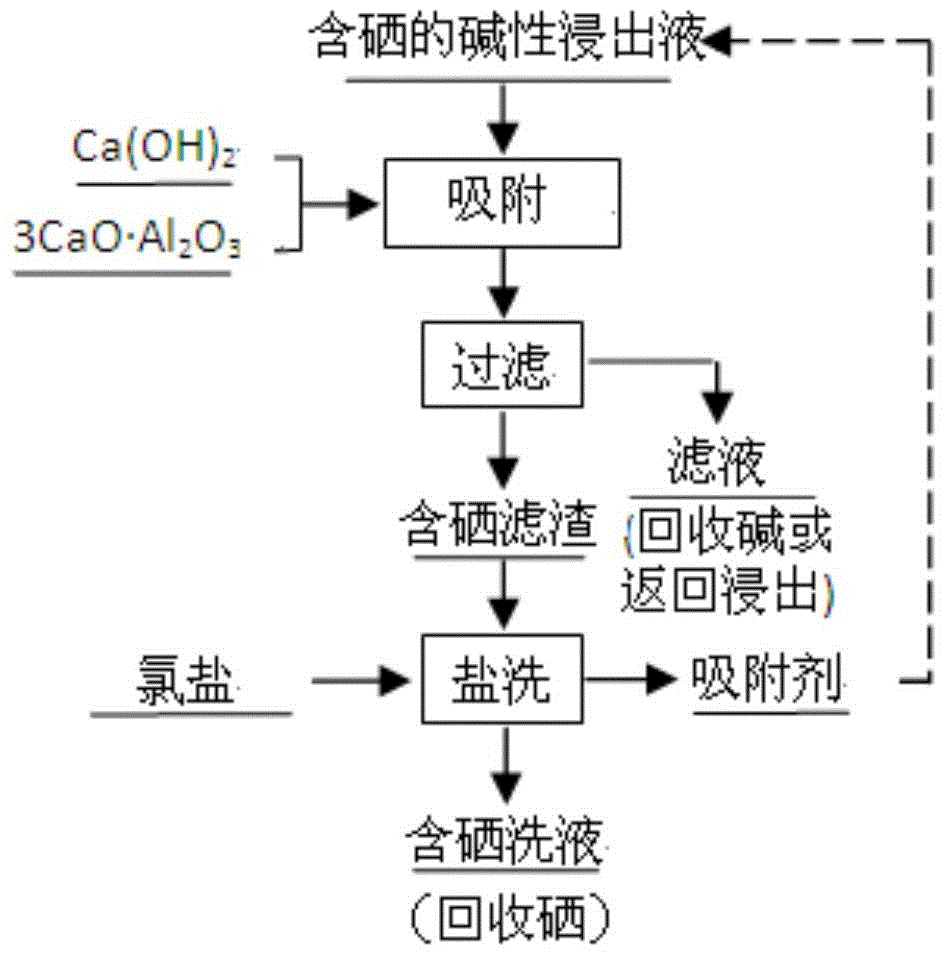Method for separating selenium in alkaline leachate
A leaching solution and alkaline technology, applied in the field of separating selenium in alkaline leaching solution, can solve the problems of high energy consumption of evaporation crystallization method and the alkali concentration of solution should not be too high, and achieve the effect of less equipment, large reagent consumption and good separation effect.
- Summary
- Abstract
- Description
- Claims
- Application Information
AI Technical Summary
Problems solved by technology
Method used
Image
Examples
Embodiment 1
[0034] A method for separating selenium in alkaline leaching solution, its technological process is as follows figure 1 shown, including the following steps:
[0035] 1) Dilute 1L alkaline leaching solution (Se: 2g / L, OH - : 0.5mol / L) was heated to 40°C, and then Ca(OH) with a molar ratio of 1:1 2 and 3CaO·Al 2 o 3 (CaCO with a molar ratio of 3:1 3 and Al 2 o 3 After mixing evenly, place it in a muffle furnace and calcine at a temperature of 1300°C for 4 hours) and slowly add it into the alkaline leachate (3CaO·Al 2 o 3 The ratio to the number of moles of selenium element is 1:1), stirring continuously for 6h, the stirring speed is 200r / min.
[0036] 2) Filtrating the solution after step 1) to obtain selenium-containing filter residue and filtrate. After testing, the selenium concentration in the filtrate is 38mg / L, and by calculation, the selenium adsorption rate in the selenium-containing filter residue is 98.10%; the alkali is recovered from the filtrate.
[0037]...
Embodiment 2
[0040] A method for separating selenium in alkaline leaching solution, its technological process is as follows figure 1 shown, including the following steps:
[0041] 1) Dilute 1L alkaline leaching solution (Se: 10g / L, OH - : 1.5mol / L) was heated to 60°C, and then Ca(OH) with a molar ratio of 1.5:1 2 and 3CaO·Al 2 o 3 (CaCO with a molar ratio of 3:1 3 and Al 2 o 3 After mixing evenly, place it in a muffle furnace and calcinate at 1350°C for 4h) and mix it as an adsorbent and slowly add it to the alkaline leachate (3CaO·Al 2 o 3 The ratio to the number of moles of selenium element is 2:1), and the stirring is continued for 12 hours, and the stirring speed is 300r / min.
[0042] 2) Filtrating the solution after step 1) to obtain selenium-containing filter residue and filtrate. After testing, the selenium concentration in the filtrate is 87mg / L, and by calculation, the selenium adsorption rate in the selenium-containing filter residue is 99.13%; the alkali is recovered fr...
Embodiment 3
[0046] A method for separating selenium in alkaline leaching solution, its technological process is as follows figure 1 shown, including the following steps:
[0047] 1) Dilute 1L alkaline leaching solution (Se: 25g / L, OH - : 3mol / L) was heated to 80°C, and then Ca(OH) with a molar ratio of 2:1 2 and 3CaO·Al 2 o 3 (CaCO with a molar ratio of 3:1 3 and Al 2 o 3 After mixing evenly, place it in a muffle furnace and calcinate at a temperature of 1400°C for 4 hours) and mix it as an adsorbent and slowly add it to the alkaline leachate (3CaO·Al 2 o 3 The ratio to the number of moles of selenium element is 3:1), and the stirring is continued for 18 hours at a stirring speed of 500r / min.
[0048] 2) Filtrating the solution after step 1) to obtain selenium-containing filter residue and filtrate. After testing, the selenium concentration in the filtrate is 135mg / L, and by calculation, the selenium adsorption rate in the selenium-containing filter residue is 99.46%; the alkali ...
PUM
 Login to View More
Login to View More Abstract
Description
Claims
Application Information
 Login to View More
Login to View More - R&D
- Intellectual Property
- Life Sciences
- Materials
- Tech Scout
- Unparalleled Data Quality
- Higher Quality Content
- 60% Fewer Hallucinations
Browse by: Latest US Patents, China's latest patents, Technical Efficacy Thesaurus, Application Domain, Technology Topic, Popular Technical Reports.
© 2025 PatSnap. All rights reserved.Legal|Privacy policy|Modern Slavery Act Transparency Statement|Sitemap|About US| Contact US: help@patsnap.com

